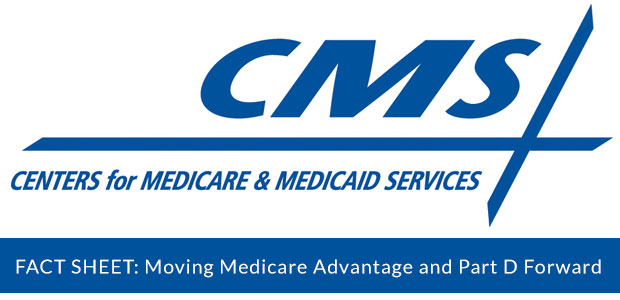The Centers for Medicare & Medicaid Services (CMS) has released this article regarding the future projection for Medicare Advantage and Part D in 2017. Keep yourself informed as we enter the Medicare Open Enrollment period this year!

Article Source: Access article here
Date: 9/22/16
Since passage of the Affordable Care Act, both Medicare Advantage and the Part D prescription drug programs have continued to grow, while premium growth has been low and quality has improved. Thanks to the successful implementation of the Affordable Care Act’s reforms, Medicare Advantage and Part D will continue to provide greater protections for beneficiaries and value for taxpayers.
The data released with the 2017 plan landscape indicate that from when the Affordable Care Act was enacted in 2010 through 2017:
• Medicare Advantage average monthly premiums is projected to fall by 13 percent.
• Medicare Advantage enrollment will have increased by more than 60 percent to an all-time high of 18.5 million Medicare beneficiaries. In 2017, this will represent about 32 percent of Medicare beneficiaries.
Many other indicators demonstrate that the Medicare Advantage program remains strong:
• Access to the Medicare Advantage program remains nearly universal, with 99 percent of Medicare beneficiaries having access to a health plan in their area.
• The average number of Medicare Advantage plan choices per county is approximately unchanged from 2016, and access to supplemental benefits, such as dental and vision benefits, continues to grow.
• Over 94 percent of Medicare beneficiaries have access to a $0 premium Medicare Advantage plan.
• 100 percent of Medicare beneficiaries – including Medicare Advantage enrollees – have access to recommended Medicare-covered preventive services at zero cost sharing.
Medicare has taken other steps to strengthen the Medicare Advantage program that include:
• Allowing Medicare beneficiaries a one-time opportunity to switch to a 5-star Medicare Advantage plan or prescription drug plan in their area any time during the year.
• Continuing the inclusion of a low performing icon on Medicare.gov (http://www.medicare.gov) so beneficiaries know which plans are not performing well.
• Implementing the Affordable Care Act requirement that all Medicare Advantage plan sponsors spend at least 85 percent of premiums on quality and care delivery and not on overhead, profit, or administrative costs.The new plan landscape also demonstrates that the Medicare Part D prescription drug benefit will continue to provide beneficiaries with affordable access to drug coverage. The average premium for a basic Medicare Part D prescription drug plan in 2017 will remain relatively stable, at an estimated $34 per month. This is an increase of approximately $1.50 over the actual average basic Part D premium of $32.56 in 2016.
In addition, millions of seniors and people with disabilities with Medicare continue to enjoy prescription drug discounts as a result of the Affordable Care Act. Since the enactment of the Affordable Care Act through July 2016, more than 11 million seniors and people with disabilities have received savings and discounts in the coverage gap of over $23.5 billion on prescription drugs, an average of $2,127 per beneficiary thanks to the law.
Moving Medicare Forward – Strengthening Medicare Advantage and Part D for All Medicare Beneficiaries
The 2017 Rate Announcement and Final Call Letter advance broader efforts at the Department of Health and Human Services (HHS) and the Centers for Medicare & Medicaid Services (CMS) to move the Medicare Advantage and Part D prescription drug programs to provide high quality care for all Medicare beneficiaries, including low income and dually eligible beneficiaries.
• Higher quality of care – the 2017 Rate Announcement and Final Call Letter includes updates to the Star Rating system used to assess the performance of plans in providing high quality care. These updates will strengthen the accuracy of the evaluation system. The Call Letter also includes an interim analytical adjustment to account for the effect of low income subsidy/dual eligible and/or disability status on Star Ratings. The adjustment factor will vary by a contract’s proportion of low income subsidy/dually eligible and disability status beneficiaries. Through this interim adjustment, CMS seeks to more accurately capture true plan performance, while work continues by the HHS Assistant Secretary for Planning and Evaluation (ASPE) and measure stewards in this important area.
• Payment reform – the 2017 Rate Announcement finalized a new risk adjustment model that has separate coefficients for partial benefit dually eligible beneficiaries, full benefit dually eligible beneficiaries, and non-dually eligible beneficiaries. These changes will improve the precision of the payments made to plans, including increases in payments for plans serving full benefit dually eligible beneficiaries, and will support health equity and payment accuracy.
Article Source: Access article here
Date: 9/22/16




